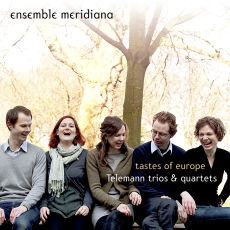Ensemble Meridiana - Tastes of Europe - Audio Video Club of Atlanta
The Ensemble Meridiana, composed of Dominique Tinguely (recorder & bassoon), Sarah Humphrys (oboe), Sabine Stoffe (violin), Tore Eketor (viola da gamba), and Christian Kjos (harpsichord), are an engaging new group of Baroque and early music artists who came together during their student days at the famed Schola Cantorum in Basle, Switzerland. Representing, as they do, four different nationalities - Swiss, Norwegian, Swedish, and English - perhaps led to a natural preoccupation with the German composer Georg Philipp Telemann (1681-1767), who did the most to reconcile the different national musical tastes of his day into a unified, or "mixed" style. Being four years older (and more precocious) than J. S. Bach, he had the distinction of attempting to do this even earlier than his famous contemporary.
The difficulty in such an undertaking as Telemann's is that one can end up being a musical chameleon without a distinctive style of one's own. The French style was flowing and tender, but also measured, precise, amenable to certain rules. The Italian was colorful, flamboyant, sharply phrased, and theatrical in its mode of expression. The German style was preoccupied with matters of harmony, counterpoint and fugue. After Telemann's example, Germany became the breeding ground for the new "mixed" style that would combine all these elements together into one. As time goes by, that synthesis would seem to be Telemann's great contribution to the art of western music.
As far as the question of this composer's distinctive style, the Meridian Ensemble make the best possible argument for it in a beguiling program of trio sonatas and concertos (that is, quartets for three melody instruments and a basso continuo of gamba and harpsichord to realize the underlying bass). The performances sparkle with the youthful excitement of discovery. They begin with a Concerto in G Major that is very much in the Italian style. It is followed by a Trio in E Minor that is French to its fingertips in its use of tierces coulées (ornaments filling the interval of a third), ports de voix (appoggiaturas, usually on the beat), and tremblements (trills starting on an upper note and always on the beat) and its movements in French dance forms, the Rigaudon and Passepied. The succeeding items in the program represent more or less the mixed style.
In the final movement, Vivace, of the Concerto in A Minor, in form a ritornello in the manner of a rondo, the recorder, oboe, and violin really get a chance to show their stuff with some bravura playing over a coruscating basso continuo by the gamba and harpsichord. Here, as elsewhere in the recital, the players show an exciting sense of ensemble that doesn't crimp their expression as individuals. May we hear more from this wonderful new group!

